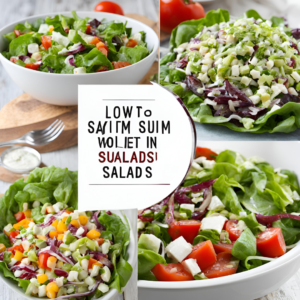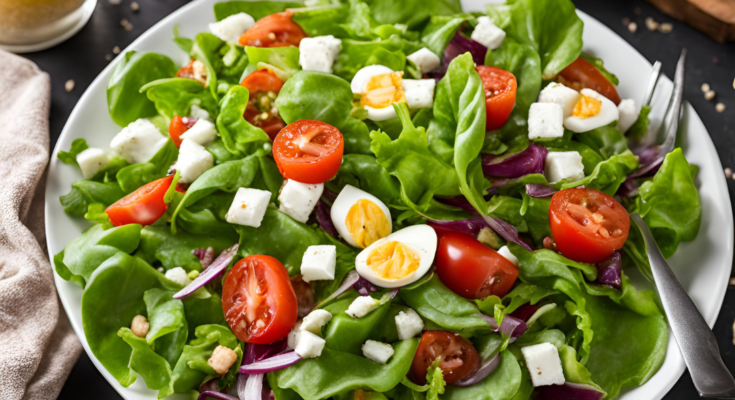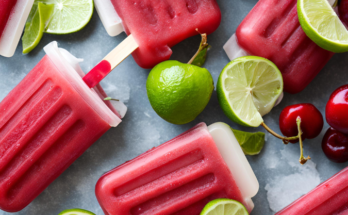Enjoy Tasty and Healthy Low Sodium Salads: Fresh and Flavorful Recipes!
Eating healthy doesn’t mean sacrificing flavor. If you’re watching your sodium intake, you might think your salad options are limited. But low sodium salads can be just as delicious and satisfying as their saltier counterparts. In this article, we’ll explore various low sodium salad recipes, tips for reducing sodium without losing taste, and why these salads are a great choice for everyone, not just those on a low-sodium diet.
Why Choose Low Sodium?
High sodium intake is linked to various health problems, including high blood pressure and heart disease. Reducing sodium in your diet can help lower these risks. Low sodium salads are an excellent way to enjoy tasty meals without overloading on salt. They’re fresh, nutritious, and full of natural flavors that your body will thank you for.

Low Sodium Salads
Simple Tips for Reducing Sodium in Salads
- Use Fresh Ingredients: Fresh vegetables and fruits naturally contain less sodium than processed foods. The fresher the ingredients, the better.
- Make Your Own Dressing: Store-bought dressings are often high in sodium. Making your own with ingredients like olive oil, vinegar, lemon juice, and herbs can significantly cut down the salt.
- Limit Processed Add-Ons: Cheese, croutons, and deli meats are often high in sodium. Choose alternatives like unsalted nuts, seeds, or fresh herbs for added crunch and flavor.
- Season with Herbs and Spices: Instead of reaching for the salt shaker, experiment with different herbs and spices. They add flavor without adding sodium.
Delicious Low Sodium Salad Recipes
1. Classic Garden Salad with Lemon Herb Dressing
This salad is simple, refreshing, and full of natural flavors. The lemon herb dressing gives it a zesty kick without needing any salt.
Ingredients:
- Mixed greens (lettuce, spinach, arugula)
- Sliced cucumbers
- Cherry tomatoes
- Shredded carrots
- Red onion slices
- Lemon juice
- Olive oil
- Fresh herbs (parsley, basil, dill)
- Black pepper
Instructions:
- Toss the mixed greens, cucumbers, tomatoes, carrots, and onions in a large bowl.
- In a separate small bowl, whisk together lemon juice, olive oil, and fresh herbs.
- Drizzle the dressing over the salad and toss to combine.
- Season with black pepper to taste.
2. Mediterranean Quinoa Salad
Quinoa is a great base for a low sodium salad. This Mediterranean-inspired dish is packed with veggies, protein, and fiber, making it a satisfying meal.
Ingredients:
- Cooked quinoa (cooled)
- Chopped cucumbers
- Cherry tomatoes
- Red bell pepper
- Red onion
- Fresh parsley
- Feta cheese (optional, use sparingly)
- Olive oil
- Lemon juice
- Garlic powder
- Black pepper
Instructions:
- Combine the quinoa, cucumbers, tomatoes, bell pepper, onion, and parsley in a large bowl.
- In a separate bowl, mix olive oil, lemon juice, garlic powder, and black pepper.
- Pour the dressing over the quinoa mixture and toss to combine.
- Add a sprinkle of feta cheese if desired, but keep it minimal to stay low sodium.
3. Fruit and Spinach Salad with Balsamic Glaze
This salad is a sweet and savory delight, perfect for those who enjoy a touch of fruit in their greens.
Ingredients:
- Fresh spinach leaves
- Sliced strawberries
- Blueberries
- Sliced almonds
- Red onion slices
- Balsamic vinegar
- Honey or maple syrup
- Olive oil
Instructions:
- Arrange the spinach, strawberries, blueberries, almonds, and onion in a bowl.
- In a small pan, heat balsamic vinegar and honey until it thickens slightly into a glaze.
- Drizzle the balsamic glaze and olive oil over the salad.
- Toss gently to combine and enjoy.
Read More: Low sodium salads
The Benefits of Low Sodium Salads
Low sodium salads offer many health benefits beyond just reducing salt intake. They are rich in vitamins, minerals, and antioxidants, all of which contribute to overall well-being. Here’s why you should consider adding more low sodium salads to your diet:
- Heart Health: Lowering sodium intake helps reduce blood pressure, which in turn lowers the risk of heart disease and stroke.
- Weight Management: Salads are naturally low in calories and high in fiber, helping you feel full without overeating.
- Improved Digestion: The fiber content in salads aids in digestion and promotes gut health.
- Better Hydration: Many salad ingredients like cucumbers and leafy greens have high water content, keeping you hydrated.
Creative Add-Ons for Your Salads
To keep your salads exciting and flavorful, try these low-sodium add-ons:
- Fruits: Fresh fruits like apples, oranges, and berries add sweetness and crunch.
- Nuts and Seeds: Unsalted nuts and seeds provide texture and a healthy dose of protein.
- Herbs: Fresh herbs like mint, cilantro, and dill can elevate the taste of any salad.
- Avocado: Creamy and full of healthy fats, avocado adds richness without the need for cheese.
Making Low Sodium Salads a Part of Your Routine
Incorporating low sodium salads into your daily routine doesn’t have to be difficult. Here are some tips to make it easier:
- Prep in Advance: Wash and chop your veggies ahead of time so they’re ready to go when you need them.
- Mix It Up: Don’t be afraid to try new ingredients and combinations. This keeps your meals exciting and prevents salad fatigue.
- Pack for Lunch: Salads are perfect for on-the-go lunches. Just keep the dressing separate until you’re ready to eat.
- Involve the Family: Encourage your family to get involved in making salads. Kids can help with washing veggies or mixing dressings.
Low Sodium Salad Dressings
The dressing can make or break a salad, especially when trying to keep it low in sodium. Here are some easy and tasty low sodium dressing ideas:
1. Citrus Vinaigrette
- Ingredients: Fresh orange juice, lemon juice, olive oil, Dijon mustard, honey, black pepper.
- Instructions: Whisk all ingredients together and drizzle over your salad.
2. Greek Yogurt Dressing
- Ingredients: Plain Greek yogurt, garlic powder, lemon juice, olive oil, dill, black pepper.
- Instructions: Mix all ingredients in a bowl and adjust seasoning to taste.
3. Avocado Lime Dressing
- Ingredients: Ripe avocado, lime juice, cilantro, garlic powder, olive oil, water (to thin if necessary).
- Instructions: Blend all ingredients until smooth and creamy, then toss with your salad.
How to Enjoy Low Sodium Salads Year-Round
Salads aren’t just for summer! You can enjoy low sodium salads throughout the year by choosing seasonal ingredients. Here’s a quick guide:
- Spring: Use fresh greens, radishes, and asparagus.
- Summer: Opt for tomatoes, cucumbers, and berries.
- Fall: Incorporate root vegetables like beets and carrots.
- Winter: Go for hearty greens like kale, along with citrus fruits.
The Importance of Reading Labels
When shopping for salad ingredients, especially dressings and toppings, it’s crucial to read labels. Many packaged foods contain hidden sodium, even those that seem healthy. Look for products labeled “low sodium” or “no added salt,” and always check the nutrition facts to ensure you’re making the best choices.
Salads as a Versatile Meal Option
One of the best things about low sodium salads is their versatility. They can be served as a side dish, a main course, or even a snack. By changing up the ingredients and dressings, you can create endless variations that suit your taste and dietary needs. Whether you’re in the mood for something light and refreshing or hearty and filling, there’s a low sodium salad for every occasion.
A Salad for Every Occasion
No matter the time of day or type of meal, there’s always room for a low sodium salad. Here are some ideas for different occasions:
- Breakfast: Start your day with a fruit and yogurt salad, using low-sodium yogurt and fresh berries.
- Lunch: A hearty grain salad with quinoa, chickpeas, and fresh vegetables makes a filling midday meal.
- Dinner: Pair your favorite protein with a side of mixed greens, avocado, and a homemade citrus vinaigrette.
- Snack: A small bowl of chopped veggies with a light dressing can satisfy those afternoon cravings.
Conclusion: Embrace the Flavor, Not the Sodium
Low sodium salads don’t have to be boring or bland. With the right ingredients and a bit of creativity, you can enjoy a variety of delicious and heart-healthy salads that are full of flavor. Whether you’re looking to improve your diet, manage a health condition, or simply enjoy fresh and nutritious meals, low sodium salads are a perfect choice. Start experimenting with these recipes and tips today, and discover how easy and enjoyable it can be to eat well without the extra salt.
Read About: Feta Pea Salad





2 Comments on “3 Healthy Low Sodium Salads”